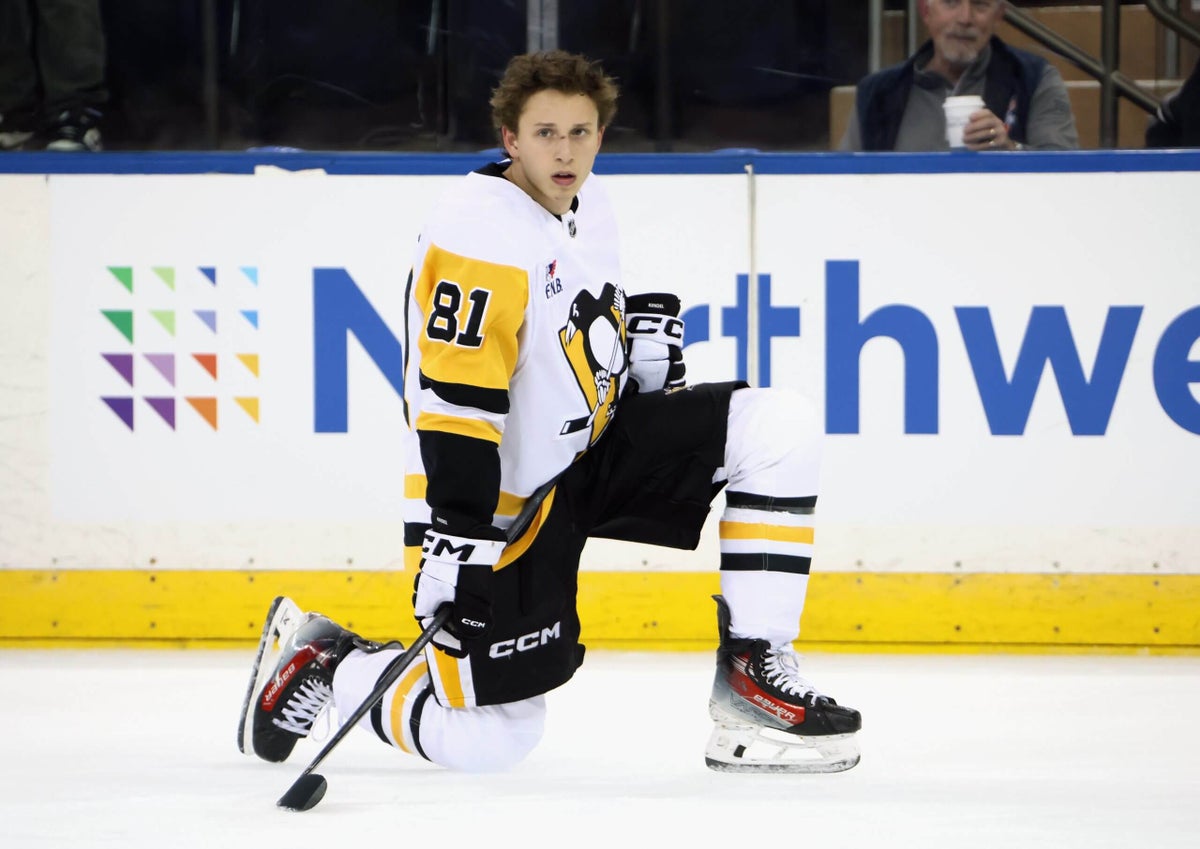PITTSBURGH — The future keeps getting brighter for the Pittsburgh Penguins.
In June, the organization was delighted with the draft haul reeled in by president/general manager Kyle Dubas and VP of player personnel Wes Clark. A few months later, it’s even more excited.
The Penguins’ internal optimism started when they hired Dan Muse a few weeks before the draft. Hiring a new coach — especially a relative no-name such as Muse — naturally comes with some level of “wait-and-see” skepticism. After a summer, a training camp and seven weeks of the regular season, I assure you the Penguins are sold on Muse.
The optimism continued with Ben Kindel, whom the Penguins drafted at No. 11. Pittsburgh was roundly torched for that decision, but a few months later, Kindel seems to have a reasonable opportunity to be a Calder Trophy candidate. At age 18.
Dubas and Clark aren’t being ridiculed for that anymore. Team sources told me they still would’ve picked Kindel even higher than No. 11 if they’d had a better draft slot.
Dubas and Clark entered the draft with Kindel ranked as the fourth-best prospect available. They fell in love with his poise, skill, hockey IQ and potential. They saw him as a legitimate, top-six center. Acquiring someone with the potential to become a top-six center is always a big deal, no matter an organization’s plight. When your top-six centers are 38 and 39, respectively, it’s an even bigger deal.
The Penguins’ optimism doesn’t end there.
If anyone besides Kindel has emerged as a first-round “steal” candidate from the 2025 draft, it’s Will Horcoff.
The Michigan standout doesn’t turn 19 until January. He was the third of the Penguins’ three first-round picks, but he could be a top-10 pick in a re-draft.
Horcoff, a hulking 6-foot-5 power forward who is still filling out, has 13 goals in 14 games for the Wolverines. When he was selected, the majority of the Penguins’ scouts really liked him and thought it was a solid pick. The one knock was that, despite Horcoff’s massive frame and impressive two-way game, he was not finishing enough to their liking. If he learned to finish, the thinking went, his stock would rise dramatically, from a projected solid middle-six forward to perhaps a top-line player.
Well, he leads the NCAA in goals.
The Penguins are giddy about his ascent. He seemingly leaped from intriguing prospect to NCAA stud in the blink of an eye.
Of course, he’s not on Kindel’s trajectory. Teenagers are rarely ready to play in the NHL, and power forwards typically require more time to become NHL-ready. That said, a team source told me the Penguins think there’s a good chance he’ll be ready for full-time NHL action within two years. They have a growing belief that, in time, he could become a top-six standout. If that’s the case, the Penguins could’ve found two such players in the same draft.
This brings us to Bill Zonnon, the second of the three first-round picks. His season was temporarily derailed by a couple of nasty injuries, but he’s finally getting his season underway in the QMJHL with Blainville-Boisbriand.
Zonnon was viewed as one of the safest picks in the draft in June, a surefire second- or third-line player with an uncommon work ethic and tenacity. The injuries have not changed the Penguins’ belief in Zonnon, whom they project to be in the NHL in a couple of years. In fact, some people I’ve spoken to within the organization believed Zonnon was the most NHL-ready of the three selections in June.
That’s how good this draft may have been for the Penguins.
Oh, there’s more
Past the first round, the Penguins also feel they have a steal in fifth-round pick Quinn Beauchesne, much like they did with defenseman Finn Harding, who was picked in the seventh round in 2024.
Beauchesne, a right-handed defenseman, like Harding, is off to a great start with the Guelph Storm (OHL). He has four goals and seven points through 12 games. Beauchesne was a standout in training camp, looking nothing like a fifth-round player. He has some buzz around him through the organization.
How the Penguins landed Šilovs
It’s easy to get distracted by Sergei Murashov because the Penguins haven’t developed a goaltender like him since Matt Murray.
Murashov’s teammates are blown away by him. But they’re also blown away by Artūrs Šilovs.
Šilovs has been one of the NHL’s best goaltenders this season. When the Penguins acquired Šilovs this summer, I talked to Jim Rutherford, who told me Šilovs had “a very real chance to become a very good NHL goalie.” The Canucks’ issue was that they were filled to the brim with goaltenders and knew they’d lose Šilovs to waivers.
Rutherford knew Pittsburgh could give Šilovs an immediate opportunity. The former Penguins GM also happens to like Dubas and doing business with him. The Penguins had salary cap space and a reasonable offer. Put it all together, and we’ve got a deal.
Goaltending is the difference
One veteran Penguins player told me that the consensus in the locker room is that the team would have been around this good last season if they had gotten the goaltending they’re getting now. He said that, yes, the additions of Kindel, Parker Wotherspoon, Justin Brazeau and Anthony Mantha have made an “obvious difference,” but “when you’re not giving up the first shot for a goal every game,” it makes quite a difference.
The veteran noted that Šilovs, Murashov and the much-improved Tristan Jarry are all responsible for the turnaround. He also mentioned Andy Chiodo, the goaltending coach. Indeed, the Penguins showed faith in him when everyone thought he’d be dismissed in the offseason.
It looks like a very sound decision.

